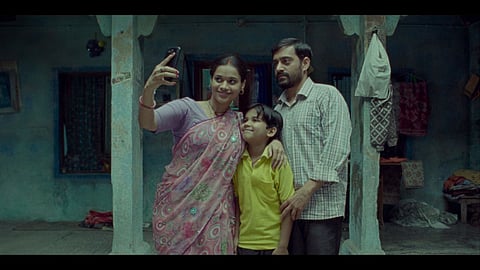Barah by Barah Movie Review: A visually stunning rumination on the death of a city
Barah by Barah(4 / 5)
There is something morbidly poetic about the city of Benaras. Its narrow lanes carry a lifeless spirit as they lead to the vibrant vastness of the sacred river, carrying the rhythmic jolts of ‘Ram Naam Satya Hai’. It is a city that is built upon legends of various kinds. Were it not married to the desire for liberation, the city would just be a mundane, dilapidated ruin.
Directed by: Gaurav Madan
Starring: Gyanendra Tripathi, Harish Khanna, Bhumika Dube, Geetika Vidya Ohlyan, Aakash Sinha, Aashit Chatterjee, Prithvi Singh
Gaurav Madan’s striking debut, Barah by Barah, catches the city on the threshold of change, as it enchants people and raptures their being.
Lured by its charm is Parbat (Harish Khanna), a former barber, who is now bedridden, weakened by the perils of old age and tobacco. He refuses the pleas of his son, Sooraj (Gyanendra Tripathi), to get treatment in Delhi. He wants to die in Benaras. If this father was someone who shaved the heads of men in a family where a death has occurred, his son Sooraj is a death photographer. Sooraj is slowly realizing the futility of his job in the age of smartphones. His services of capturing the corpses through his lens might not be required anymore. Stuck in the narrow visions of the city, he is pitted against its everyday happenings. When he is not waiting for a customer at the ghat, Sooraj clicks pictures of his wife, Meena (Bhumika Dube), or blows tunes on his harmonica. There is some solace found in the company of his friend, Dubey (Aakash Sinha), with whom he lights up chillums and rides in the city on his scooter.
There is more happening within the layers of the film, which builds upon the towering conflict. The sound design livens up the construction taking place in the city, with continuous reverbs of hammerings and wreckage. The sound becomes part of the storytelling as it reflects the frustration felt by the characters. Scenes are textured with sloganeering heard in the backdrop. People are protesting the move by the government to gentrify the city. Present at the forefront, and shouting at the top of his voice, is Dubey, as he struggles to let go of his ancestral home. However, director Gaurav is conscious not to let the film become a mere slogan. With a careful interplay of audio-visuals, you are brought closer to the experience of reconstruction that the city is going through. The irritation felt by Dubey is shown as he whips the seat of his bike with a cloth, while the wall behind bears messages of development by the current regime. As Dubey keeps beating, the sound resonates with the impact of debris falling on the ground nearby. The angst felt by the individual intermingles with his surroundings.
Among the major highlights of the film are its desaturated, grainy frames, shot on a 16mm celluloid camera. Cinematographer Sunny Lahiri creates spectacles out of everyday life in Benaras. His images catch much more than what is under immediate display. A death occurring during the spirited occasion of Holi is shown through a bird’s eye view, as the body is taken to the Ganges, with colours getting splashed on it from all sides. When they are not catching such an extravagant irony and edging towards philosophy, the images give us a fresh look at mundane things. A tenderly shot intimate scene has barely visible naked bodies, softly painted by a shaft of light through the window. A brother and sister lie down on a boat in the Ganges filled with glowing diyas, as they mull over their life. There are many instances where the visuals just take you into a trance. They carry beauty without romanticism and sorrow without cynicism. It is a calculated mix, shot intricately on celluloid, carrying the feel of a still painting and serving as a staggering document of a city that was.
Barah by Barah is also backed by powerfully sombre performances. Gyanendra Tripathi stands out with his cannabis-smoked, bulgy, dark-circled eyes, creating a distinct sense of loneliness. Bhumika Dube carries the middle-class charm of the housewife, mother and tailor, quite well. It is her little exchanges with Sooraj that feel like the last leaf of a withered tree. Geetika Vidya Ohlyan, who played the titular role of a cop in Ivan Ayr’s hard-hitting Soni, is striking in her role of Sooraj’s sister, returning to Benaras after years. The characters feel like they belong to the space. There is almost no façade of a ‘performance’. All of them give an impression of having lived forever within the grainy undercurrents of the frame.
The triumph of Barah by Barah lies in its unrestrictive filmmaking. It is not just about life, death, Benaras, or photography, but exists as a careful confluence of everything. The unhurried unfolding makes it almost seem anthropological with the study of these characters and their place over a period of time. Putting its lens on the nature of change and the motivating factors, the film focuses on how lives are altered due to it. The city meets a fateful death while the inhabitants are forced to find a bittersweet liberation.


